Archive for the ‘Fine Art’ Category
Chasing Bits a Web Platformer Game
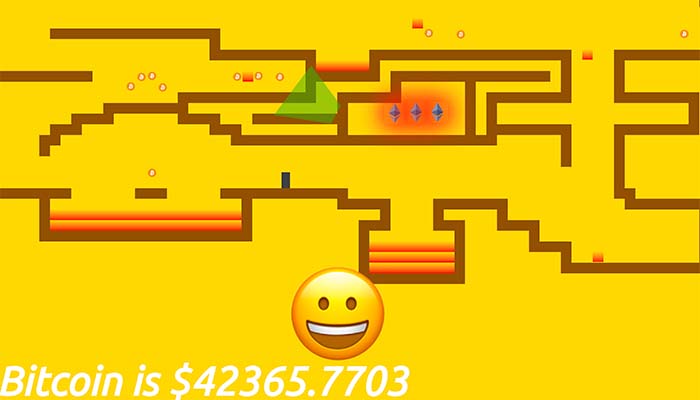
“No Media” is an online exhibition featuring art work entirely made from code. This means no media files – no jpg or gif or png or mp3 or wav or mp4 or webm or any type of self-contained file type. When I was invited to participate in this exhibition, it was a tricky proposition for me as I’m primarily a visual artist who uses software and generally when I code it’s in an environment such as Visual Studio with Unity. My web projects tend to include SVGs created in Illustrator or video or audio files… But I greatly appreciated the invitation and the challenge to work differently. However, I’m not a good coder, generally, I hack things together or review endless tutorials. In grad school at Carnegie Mellon University, I was allowed to enroll in the Computer Science intro to programming undergraduate course. This is a course designed to weed out those who will not go on to become programmers; I lasted three weeks.
I regularly use javascript, the language of the web, I wanted to make something that would be fun for people to interact with and I had been researching digital currencies for the last couple of years for another project. Since I was 11 years old, I’ve loved platformers due to my initiation as Activision’s Pitfall Harry in 1982. So I decided to take Marijn Haverbeke‘s entirely code-based javascript platformer game covered in his book Eloquent Javascript and inject it with a bit of Bitcoin and alt coin content. I feel that the platformer presents the ideal game metaphor for the dreams and pitfalls of alt coins. The game titled Chasing Bits has audio, but it’s the browser’s speech synthesis that reads a hidden text (no media). And there are emojis that may appear to be image files, but are also bits of code. (It’s probably time to add the death emoji.). There is one live data feed – the current value of Bitcoin which you may update throughout the game.
Since web audio generally requires a user event, players must click a button to trigger the browsers reading of the following passage:
What happens when a utopian idea for a decentralized currency gains adoption in the midst of hypercapitalism? Speculative investors looking to get rich quick, loose. The early bird gets the worm, the rest just dig for fools gold. Or perhaps the current value of bitcoin will triple and you head straight to the Cayman Islands to sip on rum and coke as you lazily sway in a hammock between shade and sunlight.
Unfortunately it is 2022, the U.S. government slowed the printing of free money, inflation has risen, uncertainty has set in and the happy go lucky period of Bitcoin and alt coins has taken a pause. Sit tight, wait 10 years and just maybe those Ethereum coins will be worth eighty thousand each! Or perhaps, the Financial Action Task Force may just clamp down and regulate Bitcoin and digital currencies due to money laundering and other criminal use of digital currencies. No one knows what lays ahead. So meanwhile, why not chase those bits…
I can not afford real property, so I buy land in the metaverse. I like going there in the evenings when I sit alone and wonder when others will join. Perhaps I will rent out some space and make more bits. However, I don’t like it when the earth quakes.
As soon as Bitcoin peaks again, I will buy a pig to store clones of all my primary organs, this way I will double my life span and live to a 180 and by then I will own a country in the meta verse and deliver my own currency. My anti gravity suit will keep me looking young. Meanwhile I will continue chasing bits.
Try the Chasing Bits, listen to that audio, check the current value of Bitcoin, I hope you are mildly entertained!
NFS NSFW NFT Exhibition Is Live!
NFS NSFW NFT is a 3D virtual exhibition produced by members of NEW INC and Rhizome’s Art & Code track. The exhibition is on New Art City, hosting a Zoom opening, minting a NFT on Foundation, and closing with a panel at Hunter College — all, to explore the critical poetics of this particular not-for-sale, not-safe-for-work, and non-fungible-token moment. The exhibition is composed of three galleries:
The NFS garden is skinned with cryptocurrency symbols and animations. Featuring work from Ricardo Miranda Zúñiga, Mark Ramos, and Bhavik Singh.
The NSFW garden is skinned with community rules and blurred graphics that platforms use to police adult content. Featuring work from Itziar Barrio, Christopher Clary, Nahee Kim, and Pearlyn Lii.
The NFT garden is skinned with graphics that corporations use to illustrate the blockchain. Featuring work from Johanna Flato, Lula Mebrahtu, Yeseul Song, and Ziyang Wu.
I contributed two works – a mock real estate advertisement and a sphere skinned with crypto logos that houses an audio file.
I created the real estate video advertisement featuring actress Sajda Waite for a desktop and virtual reality app titled Desplazados. Desplazados is a wandering world application set in a 19th century tenement neighborhood. One explores the environment populated by disembodied voices that share observations and personal stories regarding urban gentrification and dislocation. The voices are street interviews that I conducted as the 1 billion dollar development Essex Crossing broke ground. As one spends time with Desplazados, old buildings explode and new glass towers rise. By the end of the 20 minute experience, one is surrounded by glass skyscrapers. The video advertisement is one of two scripted elements in the app.
The crypto sphere presents logos of some of the more prominent crypto or alt currencies. When one enters the sphere, you hear a snippet of a conversation with artist Grayson Earle who created Bail Bloc, a blockchain app that when running on one’s computer generates funds for the Immigrant Bail Fund of New Haven CT that aids immigrants detained by ICE. The interview is part of a project I’ve been working on over the past year titled FinTech for the Precariat that investigates the effects of emerging financial technologies. As with Desplazados the project is a desktop and VR app that will feature 12 interviews with artists, financial specialists and individuals who have been living in financial distress.
Both these projects question speculative commerce and investing and the disparity and distress that the financialization of human existence causes.
Lindsay Howard wrote an inspiring essay regarding web3 and the possibilities of decentralized currencies and collective action. Written in a manifesto style that condemns the exploitative nature of web2.0 social network corporations, the essay is titled “Innovative Economies.”
Question of Intelligence
Before COVID-19 shutdown New York City, I had the opportunity to experience the exhibition “The Question of Intelligence – AI and the Future of Humanity” curated by Christiane Paul at Parson’s Kellen Gallery. I did not enter the exhibition expecting to witness disparate algorithms animating the exhibition space. It took me a few minutes to realize that the empty gallery (populated only by myself and two silent gallery sitters busily working, I suppose, on their school work) was brought to life by artworks forced to listen to one another and respond. I’m talking about artworks sensing via microphones, cameras, the internet; processing through artificial intelligence, machine learning, algorithms; and communicating via speakers, projectors, screens, printers, the internet and miniature swamps.
Christiane Paul has assembled elder artificial intelligence artworks over 40 years old (though still learning) with nascent works just starting to realize themselves. With the popular explosion of catch phrases including “Big Data,” “AI,” “Machine Learning,” “Today, right now, you have more power at your finger tips than entire generations that came before you…” (I used to appreciate Common before the Microsoft commercial, now I cringe when I hear his voice), Paul has curated a learning experience that recognizes the generational history of artificial intelligence as a creative medium.
Upon entering the gallery, one hears female artificial voices generating poetry or relating temperatures and soil humidity and other environmental measures or in the distance an occasional tweet. To the left, I saw a big black microphone and elected to approach it as the first means toward interactivity. I introduced myself and then watched my words projected onto the wall along with Chinese-style landscape paintings. Trails are drawn from word groupings to word groupings along with drawn landscapes and icons forming a word and image map. The projection is a mind map generator based on the words captured by the microphone. Following a few phrases, I decided it wasn’t very interesting and decided to move on. Adjacent to it is Lynn Hershman Leeson’s chatbot Agent Ruby (2001), but having interacted with one of Leeson’s works at Yerba Buena’s “The Body Electric” recently, I only spent a minute with it before moving on, also it didn’t know what to make of what I was telling it.

Adjacent to the chatbot, is Lior Zalmanson’s “image may contain” in which the artist feeds historically significant images into FaceBook’s Automatic Alternative Text image recognition algorithm, an accessibility AI to help contextualize images for the blind and sight impaired. The artists uses the uncontextualized and minimal description of the historical images to identify “similar” images and then collapses them onto lenticular prints. Above are the images that appear in the first print as I move from left to right. The work simply and clearly shows that bots such as AAT should not be used to present information and least of all pretend to be a source of knowledge, at least not yet.
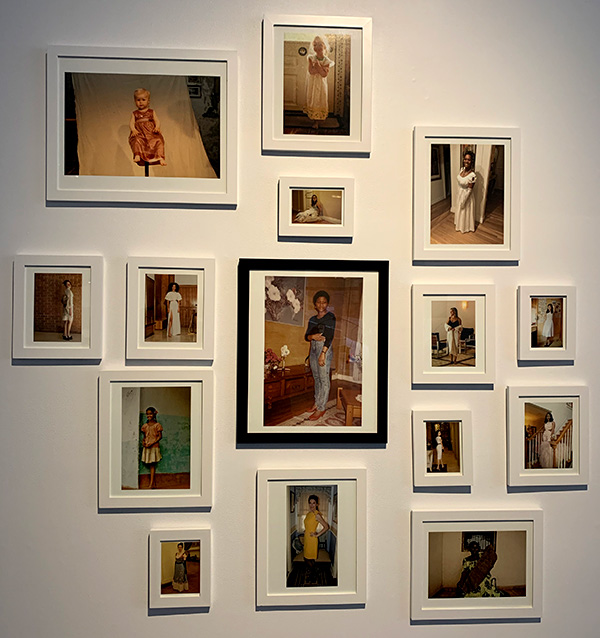
Similarly, Mimi Onuoha uploaded a photo of her mother “to Google’s reverse image search, which allows one to upload a picture to find online images that the Google algorithms identify as related.” Scaled, printed and framed from the initial image at the center to the algorithmically related images encircling, a seemingly family home portrait wall appears, leading one to question the process of algorithmic categorization based entirely on visual similarity. With such a project, I can’t help but recall eugenics and Sekula’s “The Body and the Archive.”
I then circled back toward the center of the gallery to try and figure out what was going on with “The Giver of Names” by David Rokeby. And it wasn’t until I read the instructions and changed the objects on the pedestal to assemble my own still life that the brilliance of the exhibition really dawned on me!
“The Giver of Names” (naming since 1990) consists of a monitor, speaker, old CCTV camera, pedestal, pile of old toys and a program that tries to understand what it is seeing through the camera to generate poetry. Once I removed the toys left on the pedestal and placed my own selection, I watched the AI go into action by identifying shapes and colors and then trying to make sense of what it was identifying or “seeing.” Those shapes and colors feed a poetry algorithm that speaks and writes to the monitor adjacent to the CCTV camera. Meanwhile, just beyond this installation, the not very interesting mind mapping microphone is also capturing this generated poetry as it echoes across the gallery and starts mind mapping away. AWESOME! The gallery is its own loop of machines churning away at one another’s utterances. This realization helped me refocus my attention and expand my time with each work. I tried to capture this in the video at the top of this entry.
Near the entrance on a wall monitor, hangs AARON which I had merely paused at for a few seconds but now returned to observe. “AARON is the earliest artificial intelligence program for artmaking and one of the longest running ongoing projects in contemporary art. Harold Cohen started creating AARON at UCSD in the late 1960s and developed the software until his death in 2016. In this video AARON produces a new color image every 10 to 15 minutes.” As one tours the gallery, AARON is quietly working away creating shapes and lines of color, artful abstractions.
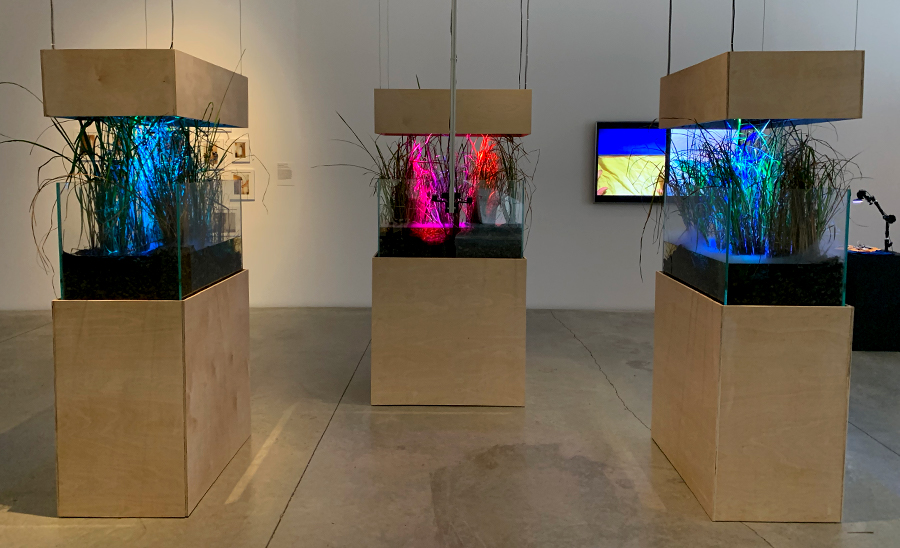
Back near the center of the gallery, just beyond “The Giver of Names” is another work with a female computer voice speaking at intervals. Tega Brain’s “Deep Swamp” asks “if new ‘wilderness’ is the absence of explicit human intervention, what would it mean to have autonomous computational systems sustain wild places?” The handsome installation has three AIs, Nicholas, Hans and Harrison each “engineer their environment for different goals. Harrison aims for a natural looking wetland, Hans is trying to produce a work of art and Nicholas simply wants attention.”
“Learning to See” by Memo Akten uses machine learning to relate the objects on a pedestal that a camera captures to five different data sets that the system has been fed. The visitor can re-arrange the objects on the pedestal to see new interpretations. Across from the pedestal on a wall is a split screen that shows the image captured by the camera adjacent to the system’s interpretation. “Every 30 seconds the scene changes between different networks trained on five different datasets: ocean and waves, clouds and sky, fire and flowers, and images from the Hubble Space telescope.
Similarly across the gallery, hang a series of prints by Mary Flanagan. The work is [Grace:AI] in which generative algorithms trained on thousands of paintings and drawings by women to create a series of images. “[Grace:AI] was tasked to create her ‘origin story’ by looking at 20,000 online images of Frankenstein’s monster and producing its portrait.”
Both “Learning to See” and “[Grace:AI]” employ generative adversarial networks (GAN), to generate new visualizations. Using GAN anyone can put their own conceptual spin to generate a data set for the machine to learn and see what it spits out. Over the last few years, I’ve seen a few similar projects, my favorite remains an early one – the MEOW Generator trained on a cat dataset.
Perhaps the most darkly monumental project are the large four black machines with spinning fans, exuding steam and ticker tape – the installation component of #BitSoil Tax by LarbitsSisters. The project proposes the fair redistribution of internet wealth to all people through a new taxation system. The installation is utopian, dark and whimsical.
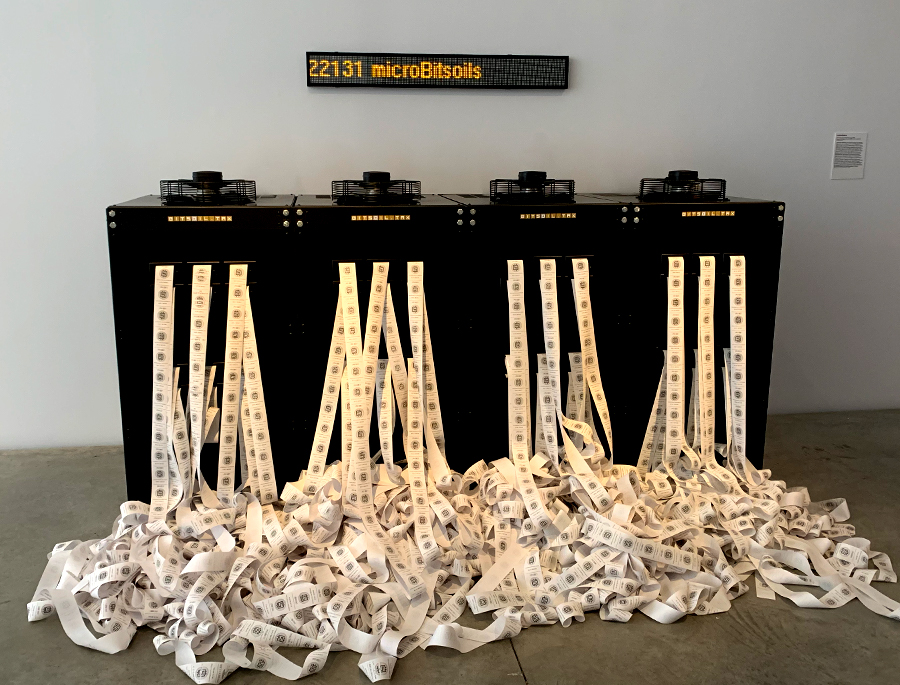
Other projects on exhibit include “Futures of Work” by Brett Wallace, and Ken Goldberg and the AlphaGarden Collective.
Pope.L Bougie Irreverence
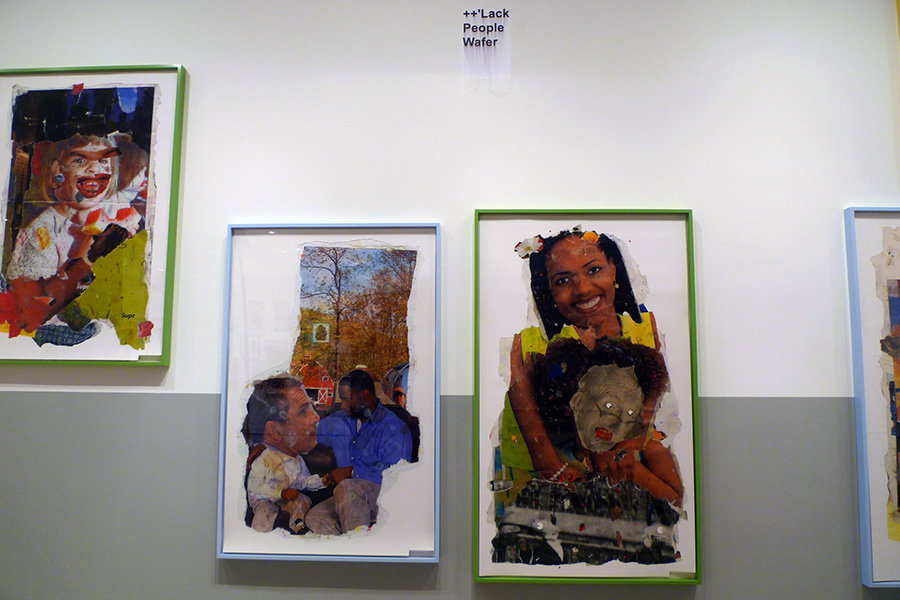
It is difficult to call any art placed in a blue chip Chelsea gallery irreverent, but Pope.L tries his best. Currently (9/13 – 10/27 2018) at Mitchell-Innes & Nash, Pope.L “One Thing After Another (Part Two)” stocks the gallery with collaged digital prints, framed found trash, assemblage, photo-collage, and a video of an erect penis attempting to balance a white whip cream pie. (As you might guess, the cream pie tips off the big, hard, black dick; only Brett Kavanaugh’s small white penis would hold that pie up.) The video is hilarious and I wish I had recorded a bit of it to include it here. It is a sharp and whimsical comment on desire, sex, race and privilege or rather lack of. The white pie and black dick are accompanied by a smoking digital black sock puppet that rises and forms like a snake from a corner of the video image.
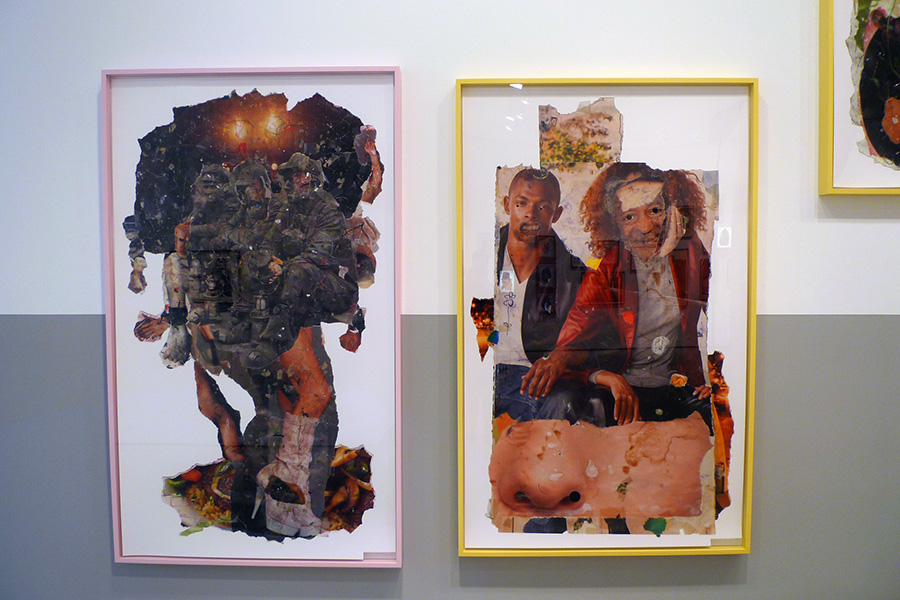
The digitally printed collages tear apart political and celebrity figures, mockingly reframing them in unexpected contexts and pairings. Across the gallery, William Pope.L has inserted himself into historical photographs. Again, the visuals are at once comical and critical recontexualizing a problematic racial history of the United States.
Pope.L effectively reminds us to always look at the images we are fed with a critical eye. Question the images – where are they coming from, why are they being presented and what is it that they represent? What is our place in this culture? But in the end, lets not take ourselves too seriously, be creative, have fun, but always be smart.
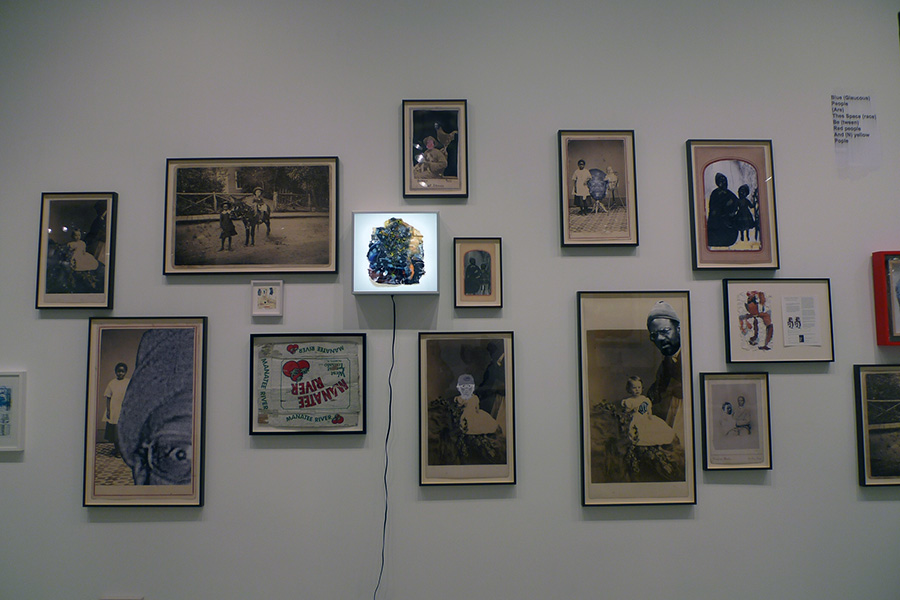
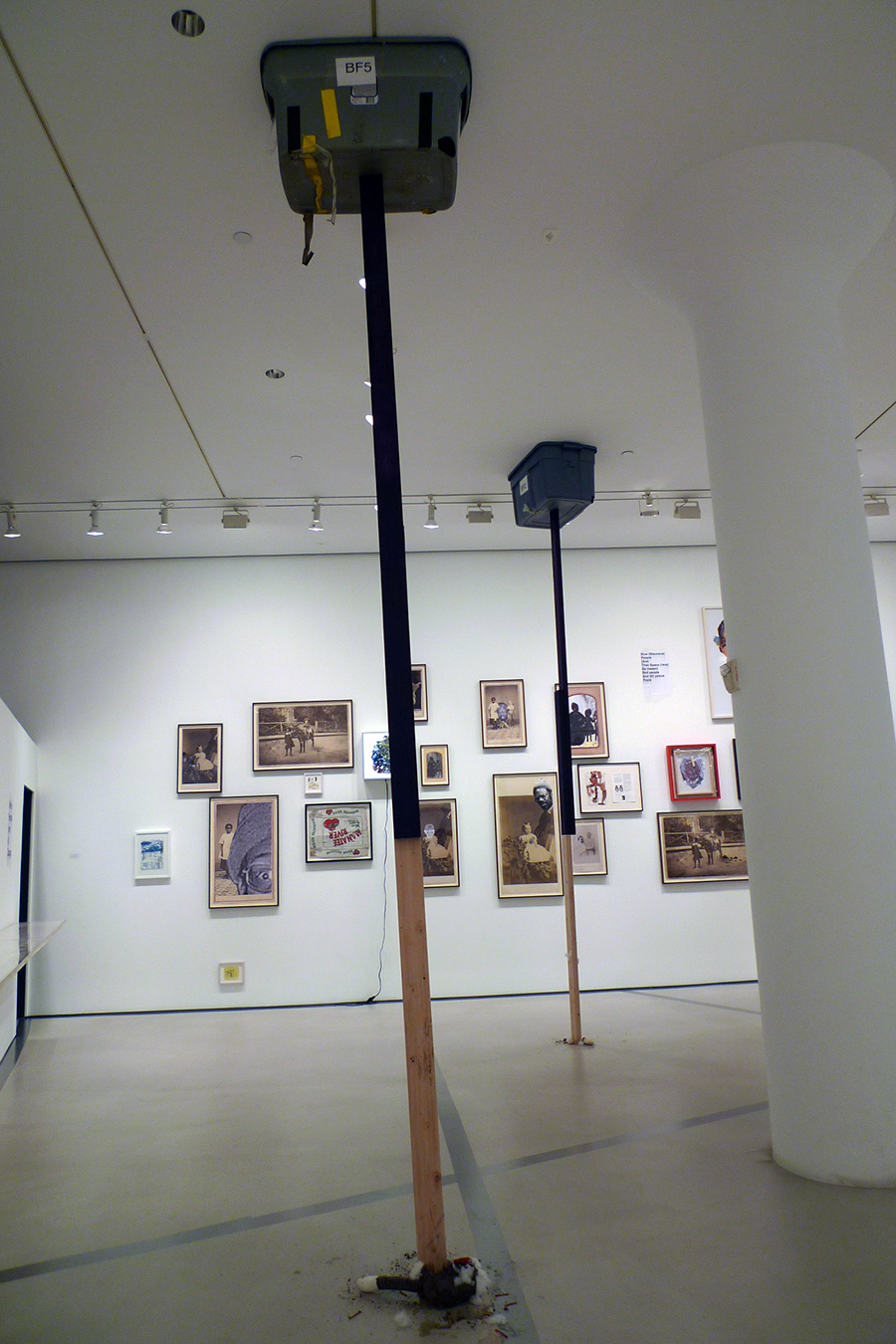
“Kusama – Infinity” Uninspired
Last night, I watched the bio documentary “Kusama – Infinity” that attempts to capture the life and career of visual artist Yayoi Kusama by Heather Lenz. Unfortunately, I came away wondering why I paid to attend a film that did not present anything that I couldn’t have learned from reading her wiki page. The film is conventional, linear and superficial. It begins with Kusama’s childhood as the youngest of four children to wealthy parents who owned a seed company. It points out the clash between Kusama and her mother which perhaps was largely based on Kusama’s obsessive-compulsive disorder that may have not been understood or her mom had little patience for. And her father’s unfaithfulness which her mother had Kusama spy upon (hence the penis soft sculptures). So the film effectively presents a “traumatic” childhood for a sensitive child.
The film documents a letter by Yayoi to Georgia O’Keeffe asking for guidance in becoming a recognized artist that O’Keeffe responded to telling her that she has removed herself from the art world which is in the cities. It continues to poorly attended exhibitions in Matsumoto, Kusama’s hometown while by the sounds of it, Kusama has been disowned by her family. However, at a time when it was expensive to fly from Japan to the United States, Kusama manages to do so. I would have liked to have known how she paid for that flight and from where she gathered the U.S. dollars that she sowed in to her kimono.
“Kusama – Infinity” does an excellent job of capturing Yayoi Kusama’s 1957-1972 period in New York City and the seemingly classic struggle of the self-obsessed artist doing whatever it takes to be shown and recognized. As an artist based in New York City, I have witnessed too many times, the young, actually also not so young artists attending openings merely to try to schmooze with powerful curators, gallerists, collectors. As in all careers, it’s all about the network and getting cozy with the figures that will help one scale the ladder. So it appears that Kusama did this relentlessly, enough so to find a patron to pay for her studio and art supplies and she used her Japanese feminine cuteness/allure to do so.
The film also attempts to paint Kusama as a trail blazer – she was the first to wallpaper a gallery, before Warhol, she was the first to do soft sculptures, before Oldenburg and a mirror room before Samaras. The first two, I don’t really buy. If Warhol was inspired by the wallpaper, great, and the cows are his images. If Oldenburg shifted from paper mache to fabric due to Kusama, smart, and again the content is his. However, Lucas Samaras stealing the mirror concept is pretty outrageous as he had not done anything like that and he basically stole Kusama’s concept and placed it in a high profile gallery. So that I can certainly recognize and even understand a self-obsessed artist dropping herself out a window (she survives due to falling onto a bicycle).
Regarding her naked body happenings, a lot of artists were doing happenings at that time. And Yoko Ono’s “Cut Piece” in 1964 seems much more powerful than any of Kusama’s performances. That said, I would have liked to have learned how she went about organizing them.
The film captures her intervention at the Venice Biennial which is commonplace today, I don’t know if it was so in 1966. The film also presents Kusama’s platonic relationship with Joseph Cornell, her move back to Japan, her re-discovery by the art world in the late 1980s and her rise to current fame. However, the film fails to delve deeply into her psyche, her persona. It does not present anything regarding her siblings and their take on her. The sequences of interview with Kusama present little depth. Perhaps there isn’t much more than obsessive compulsive disorder fulfilled by painting dots and a relentless desire for fame. Unfortunately the film is boring, but short enough that it doesn’t get tedious.
NEGOCIO at Centro Cultural Las Cigarreras de Alicante
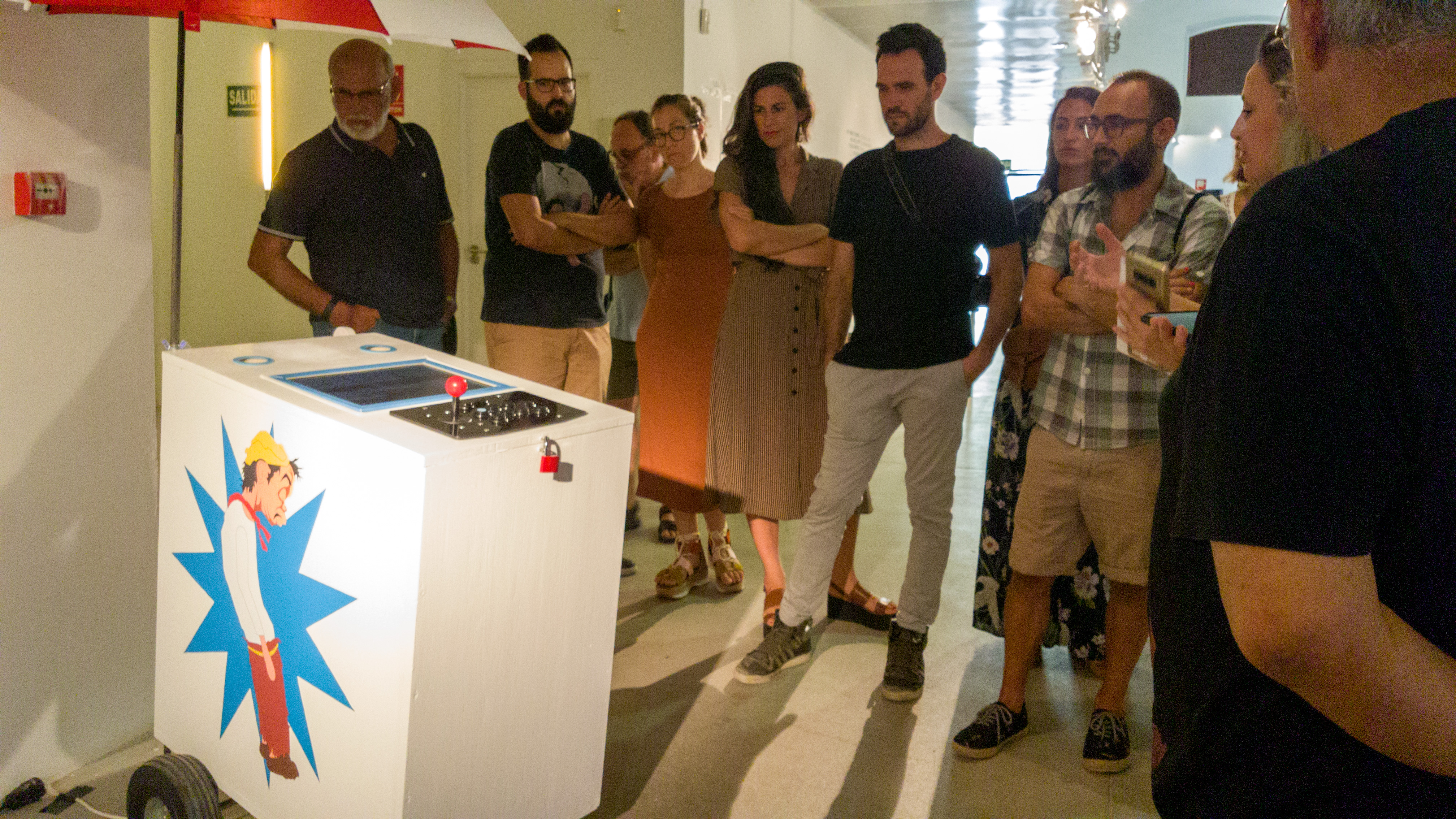
NEGOCIO at el Centro Cultural Las Cigarreras de Alicante is an ambitious attempt to present an archive of the creation of games as art largely over the last twenty years, though one work – “White Chess” by Yoko Ono dates back to 1966. The majority of works have been created in the 21st century. The exhibition presents a mix of digital and analog games and the vast majority of the exhibition is interactive – allowing visitors to play the games on exhibit as intended by the artists.
I’ve been honored with the inclusion of VAGAMUNDO: A Migrant’s Tale (2002) included the exhibition (pictured above). This is a sculpture and video game originally presented on the street that unfortunately is as timely today as 16 years ago due to the Trump administration’s stance regarding immigration.
The curators – David Machado Gutierrez, Alba Garcia Martinez, Beatriz Martinez-Villagrasa and Miguel Soria Andurell state:
The origin of the game, is lost in the memory of time; the game is perhaps as old as the very existence of the human being on earth. But what does the game transmit to us today apart from its playful appearance? Can art use it as a tool that reflects on challenges and social reality? Does it also work as an act of criticism? This exhibition does not pretend not to answer these questions, since it would be too ambitious, but it is formulated so that the spectator participates and, using the works of art as a guide. The exhibition investigates in the multiple planes what may unfolds in games as art.
Below are a selection of photographs documenting the exhibition.
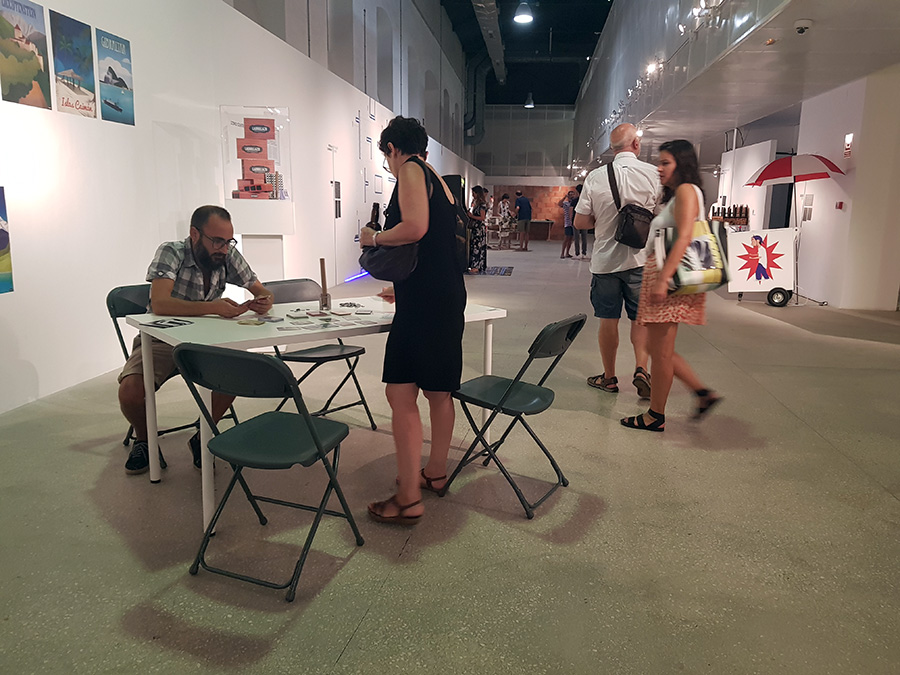
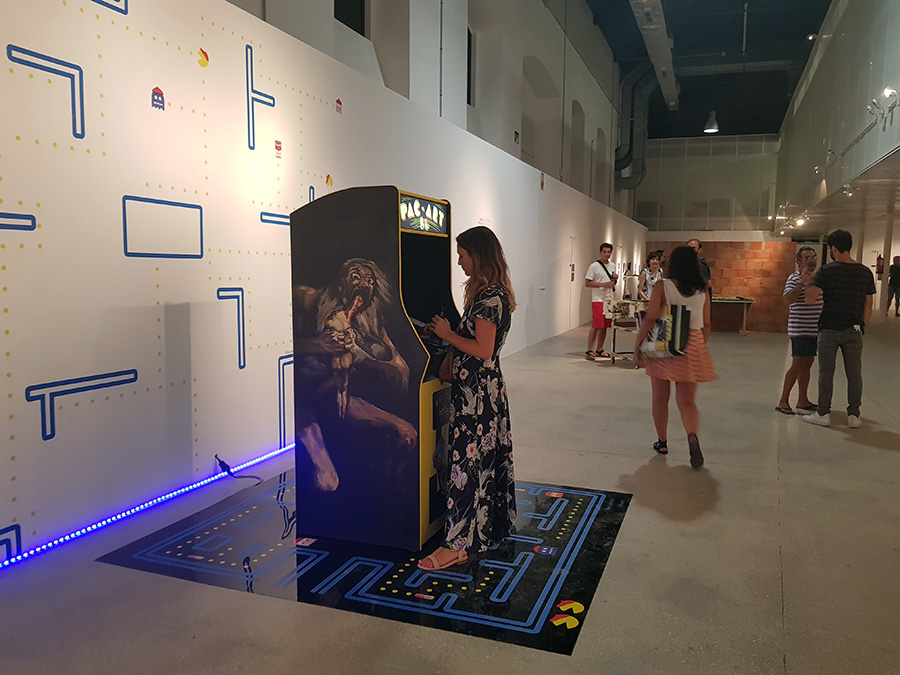
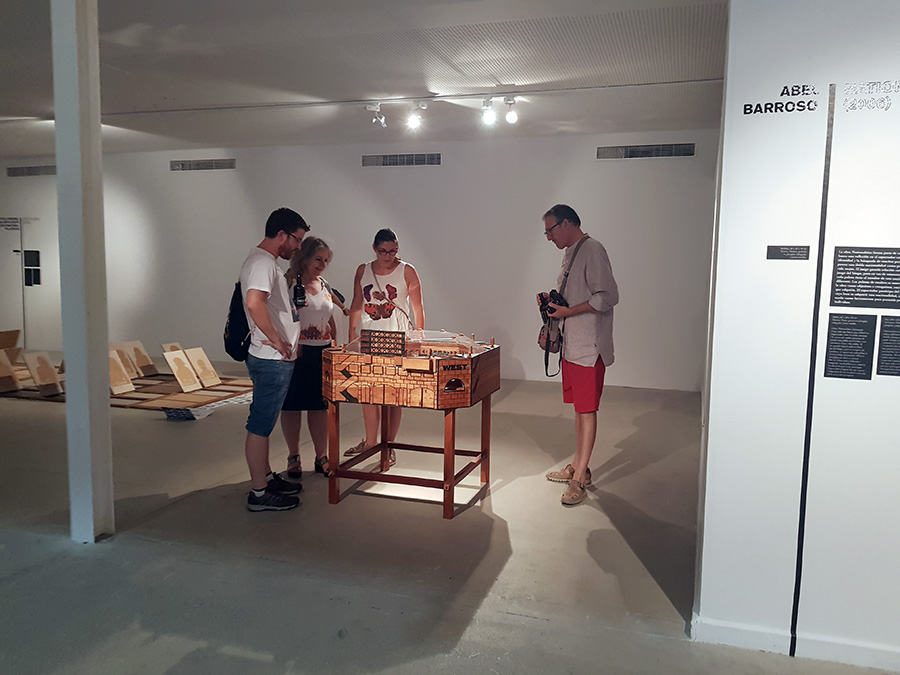
Two game sculptures by Cuban artist Abel Barroso
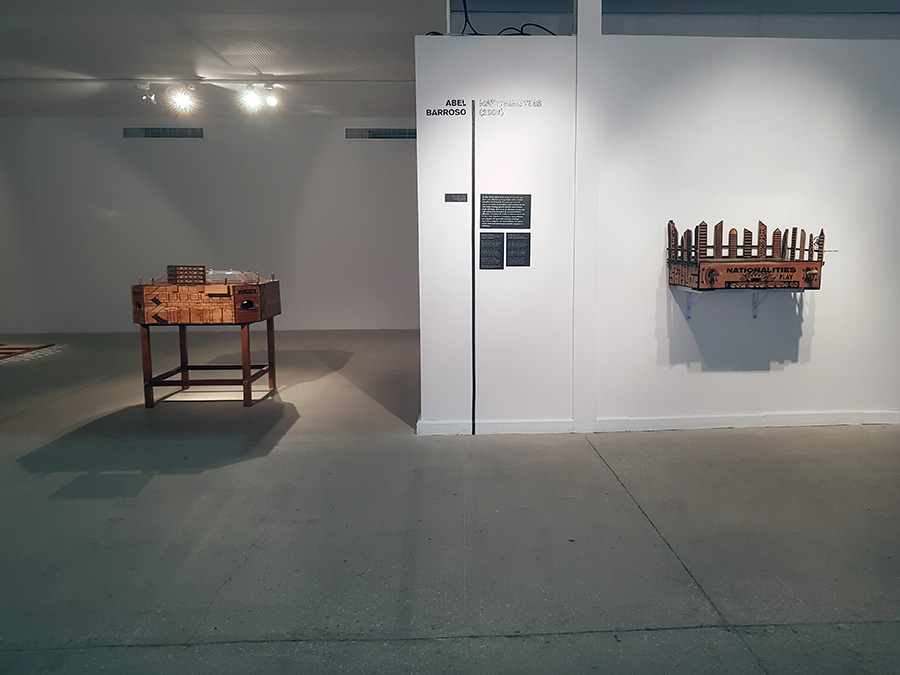
Carlos No’s Intifada – a “ping-pong table which, in place of a net, has been divided into two halves by a very high brick wall, topped by barbed wire that heightens a feeling of insurmountabilty. There arises in the spectator the curiosity of seeing the other side, the place which one is forbidden to see and be in, as if one had discovered Lewis Carrol’s charade in the passage to the other side of the looking-glass. In this wonderland that comprises this side and the other side, both the space and the visitor’s steps are divided into two.”
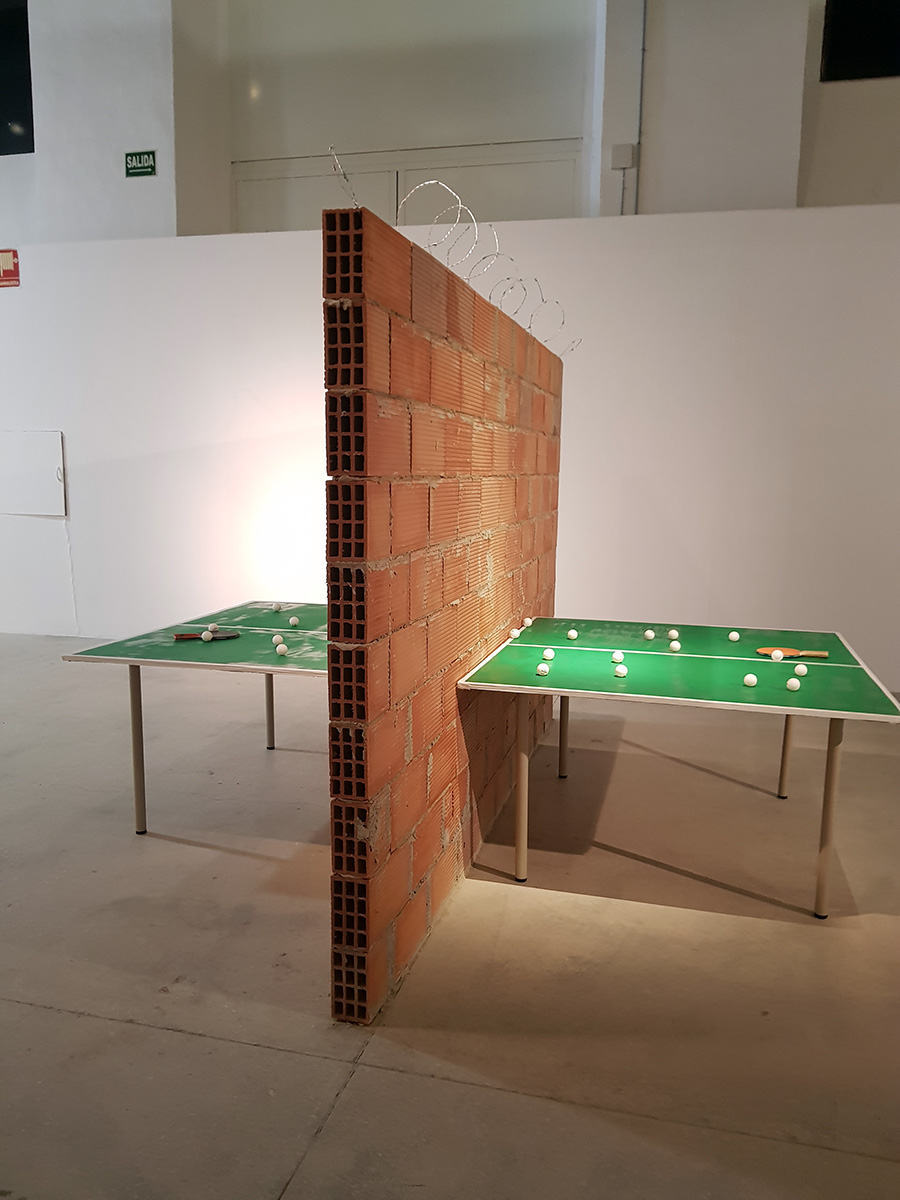
“Velvet-Strike is a mod of the first-person shooter video game Counter-Strike. The mod, developed by Anne-Marie Schleiner, Joan Leandre, and Brody Condon, adds “protest sprays” to the game’s existing graffiti function.”
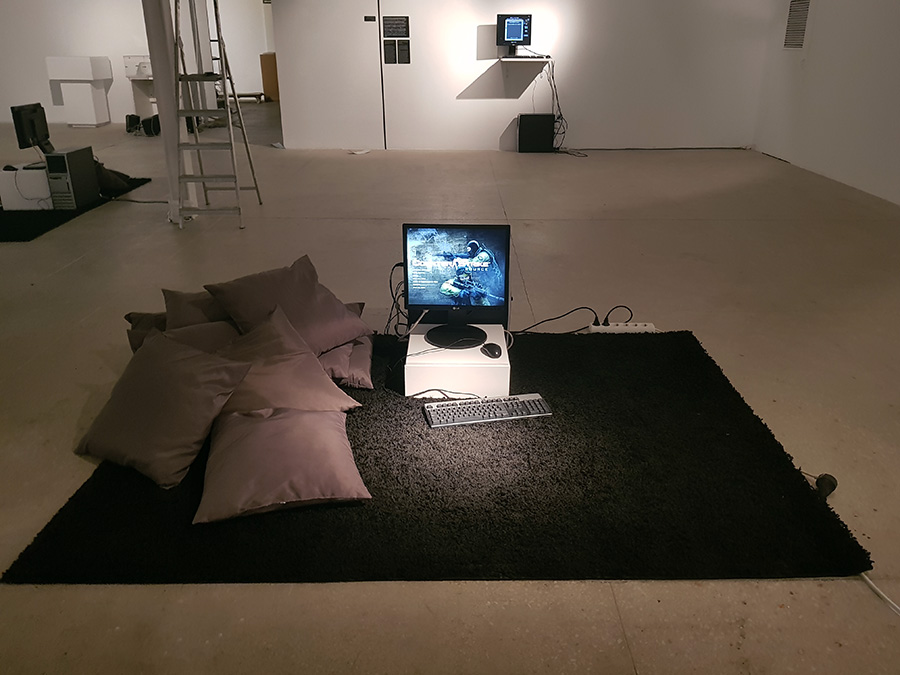
“Ladrillazo is a historical game that takes you to the real estate bubble of the first decade of the 21st century. There were days of wine and roses, an interpretation center in each town, an airport in each city, mortgages at 40 years, masons with minister salaries, Olympic dreams, AVEs and golf resorts.”
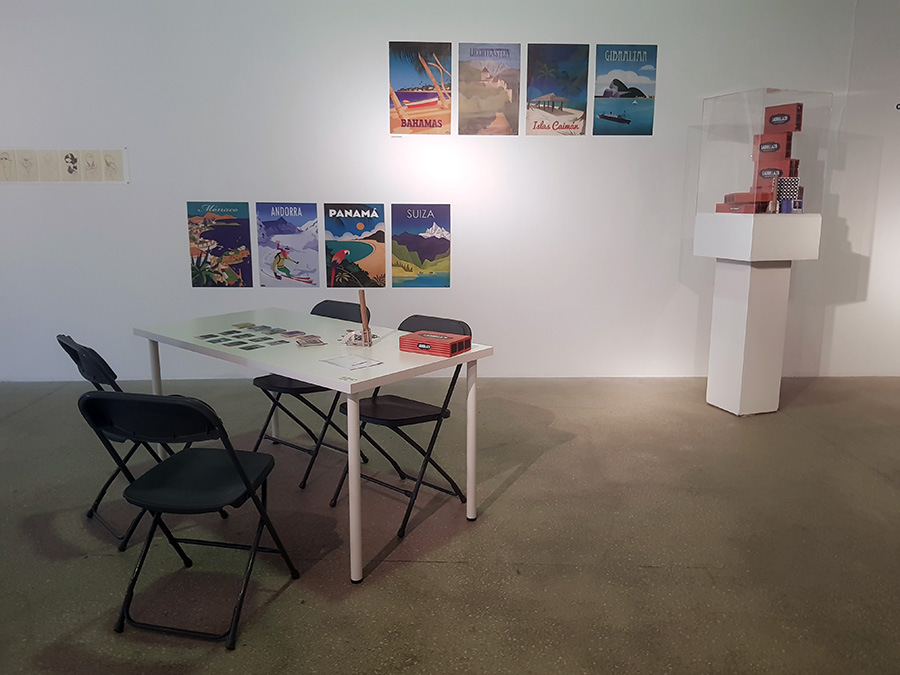
“Pac-Art is a version of the immensely popular Arcade video game Pac-Man. In this case, Pac-Art has transformed Pac-Man into an artist who has to devour famous works of art and flee from ghost-artists who threaten him.”
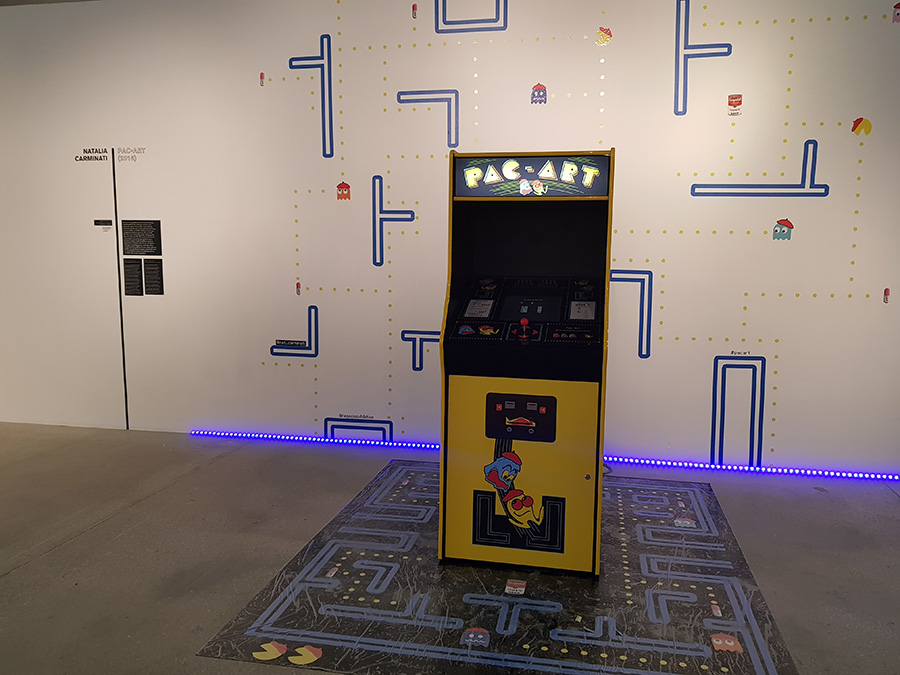
Ravalpoly by Alba Refulgente – a game of real estate speculation in Barcelona that re-contextualizes the game Monopoly.
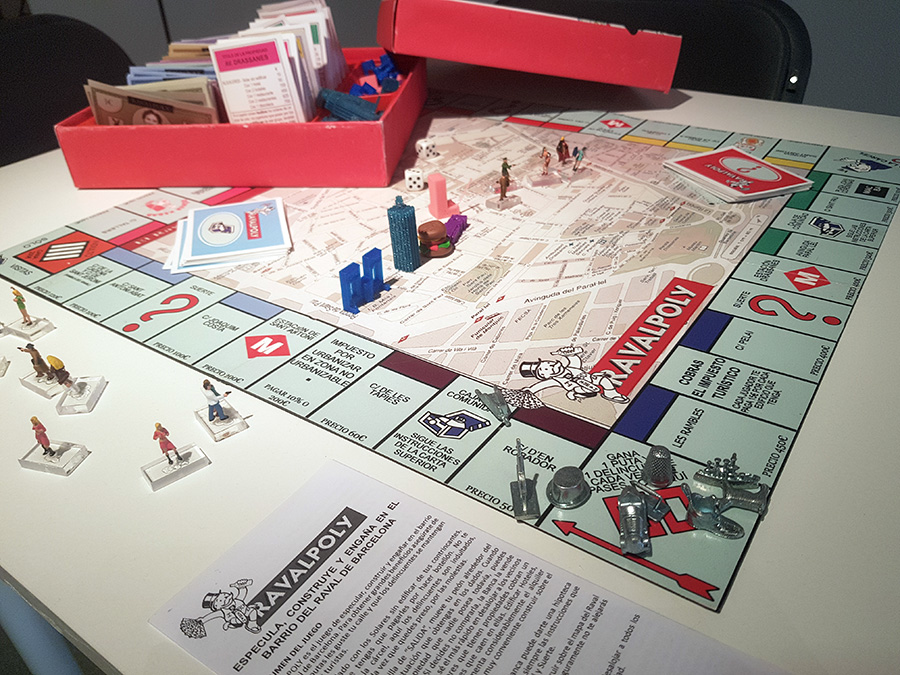
Visitors will have the opportunity to play Yoko Ono’s “White Chess.”
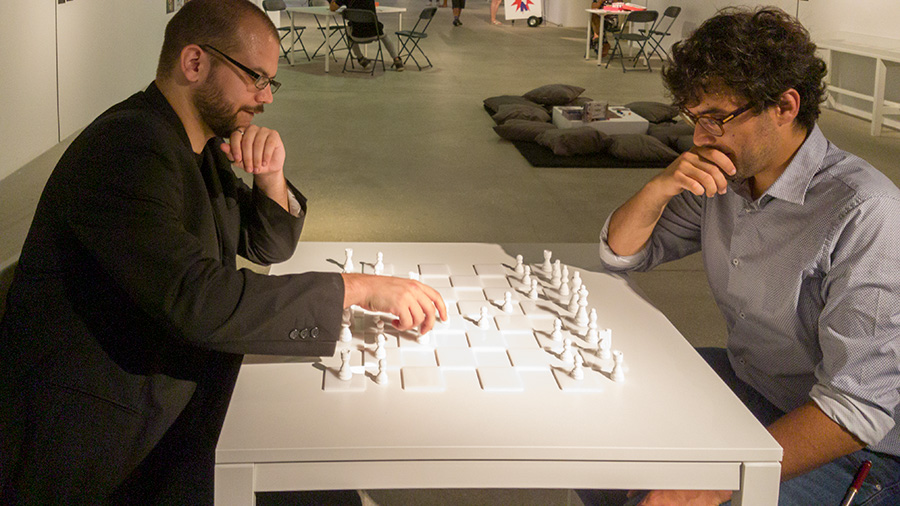
Many other artists and game makers are included in this exhibition, including Brenda Romero, Connor Monahan, Molleindustria, Richard Hofmeier, Jason Rohrer, Joan Priego amongst others. And one more image of VAGAMUNDO:
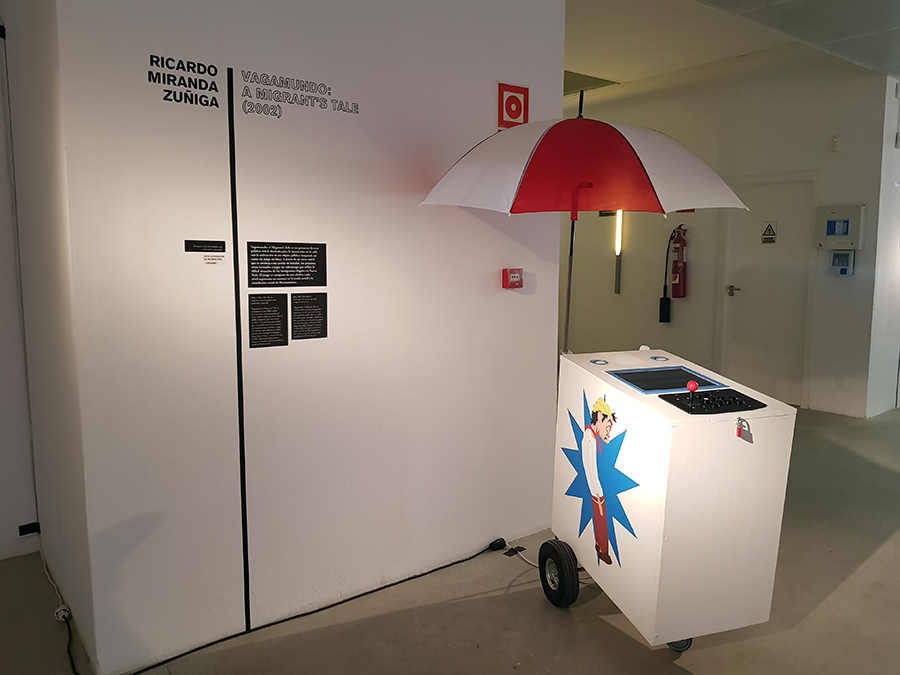
RAMMELLZEE: Racing for Thunder
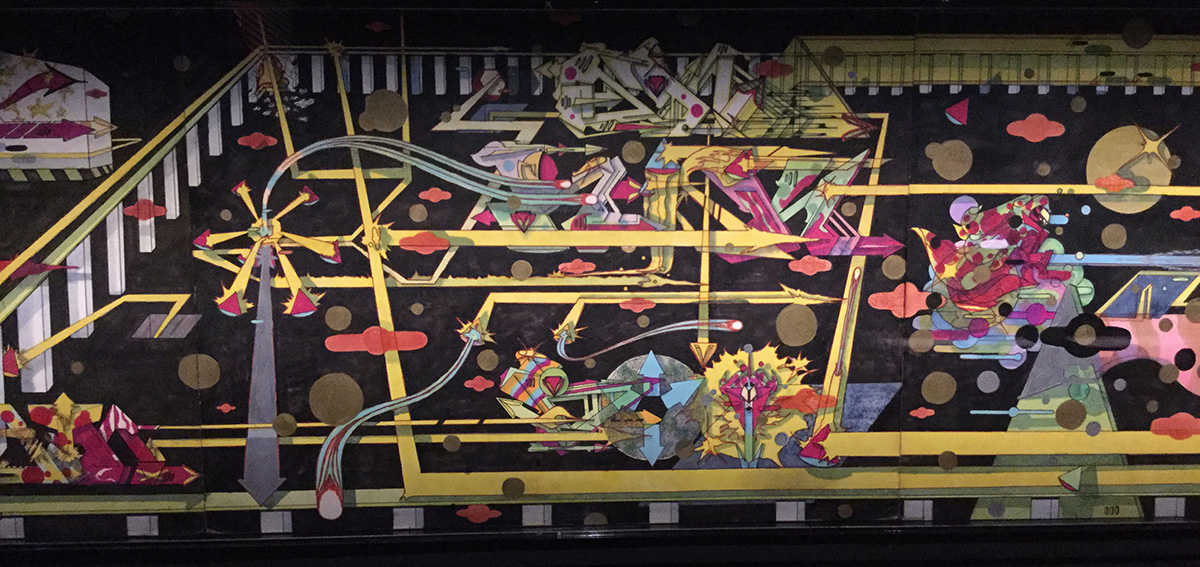
“RAMMELLZEE: Racing for Thunder” at Red Bulls Arts New York opens with sketches for the artist’s graffiti pieces. The drawings immediately bring to mind images of subway cars from the late 70s covered with graffiti. And some visitors may as well recall their own sketch books from the 70s and 80s filled with tags and letter designs for possible pieces to be realized on the street. These early works are the strongest 2D work by Rammellzee that are included in the two-floor exhibition.
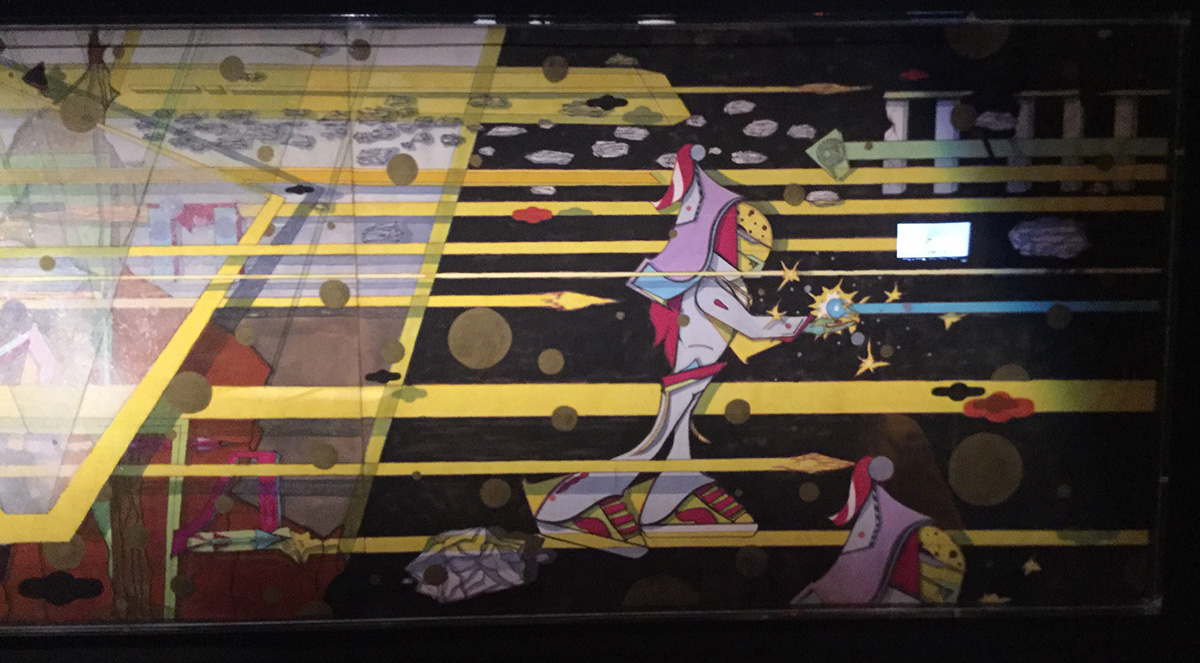
As one continues through a dark tunnel lined with early 2D works and iPad slideshows accompanied by audio recordings by celebrities, one will enter a screening room. Projected across bleachers are an assortment of video sequences capturing the artist rapping, lecturing, performing. One video capturing Rammellzee rapping from his Beat Bop classic at a club includes drawings, text and animation by Jean-Michel Basquiat superimposed over the performer. You can see the video here Rammellzee, Toxic C1 and Basquiat Live at the Rhythm Lounge 1983. There is also a sequence from Charlie Ahearn’s 1982 “Wild Style” featuring Rammallzee performing on stage. Perhaps amongst the most entertaining sequences are Rammallzee performing as a Garbage God in outlandish costume to Northern European gallery goers who complain to watch his back as he makes his way through the small crowded gallery. Also entertaining (for short bits) are his lectures to perhaps student audiences to his exhibitions, also costumed as a Garbage God and at one point shooting fire from his mouth (which was awesome to watch and hear the gasps from the live witnesses).
Proceeding beyond the screening room, one enters a large gallery with primarily 2D pieces. These works are spray painted works, epoxy frescos, assemblage wall pieces combining found objects, spray paint splashes and loads of resin. Some works feature space ships flying through spay paint environments. For the most part these works seem uninspired and more like 80s bad art.

By far the best work are the Garbage Gods and Letter Racers in the downstairs. Unfortunately, Red Bulls Arts decided to attempt to re-create the sensibility one may imagine from Rammellzee’s Tribeca loft – Battle Station by using black light. However, this isn’t the famed Battle Station – playground of the artist; this is a fancy art gallery and the black light is unnecessary. The black light makes it difficult to fully appreciate the Garbage Gods costumes that Rammellzee would perform in or the small figures that he created. As someone hoping to fully appreciate this inspired, meticulous work, skip the black light and allow us to carefully study these works. I would have preferred to see these works in this lighting:

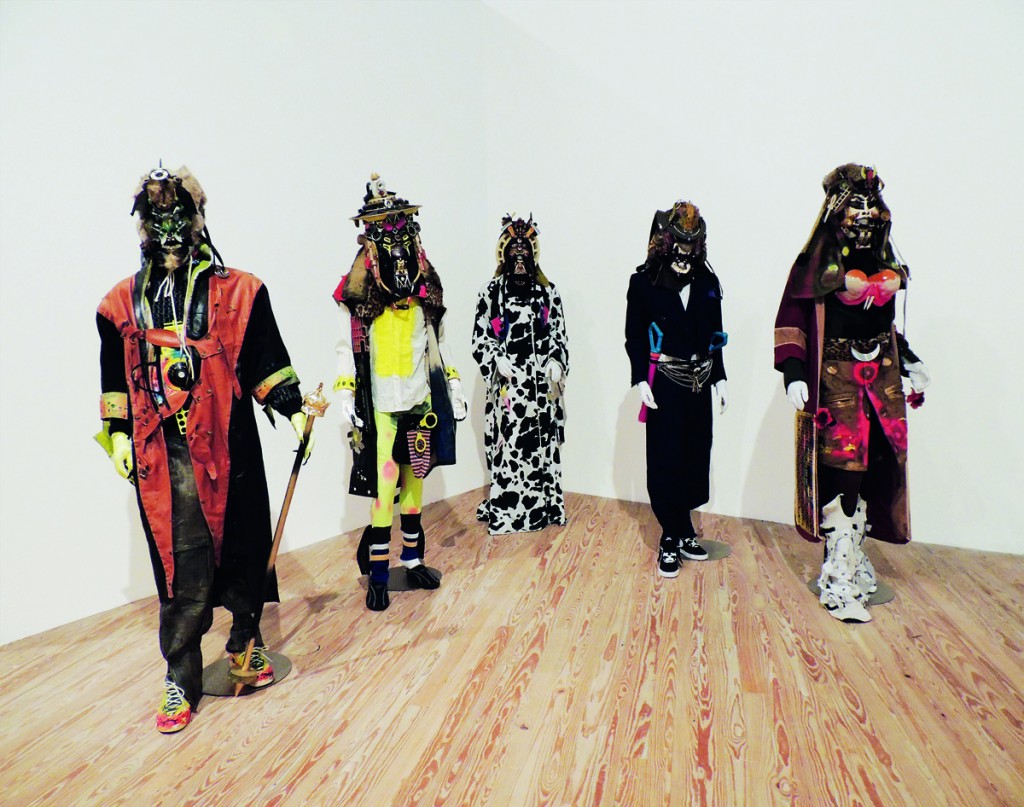
In considering this exhibition, I came upon this excellent NY Times 2012 article on Rammellzee that is worth a read, if interested in his work and life. However, if you have a free couple of hours, “RAMMELLZEE: Racing for Thunder” exhibition is a great way to intimately learn about the artist directly through his voice from hours of archival material. Amongst the 2D paintings on the top floor, there is a small listening booth with extended interviews with the artist discussing his life and philosophy. There are also videos with Rammellzee working in the studio, discussing his ridiculously toxic practice as you watch him pouring gallons of resin and spray painting indoors without a mask. Red Bull Arts has done an amazing job of creating a rich portrait of the artist.
Northeast Exhibitions Editor for caa.reviews
Over the past year, I have been working as the Northeast Exhibitions Editor for caa.reviews and thus far it’s been a great experience! Fortunately, my job is relatively easy or perhaps better stated fun. I search out exhibitions that deserve to be reviewed throughout the Northeast (but not including NYC). As I find, important exhibitions, I then need to identify potential reviewers. I had heard that commissioning non-paid reviews from people was difficult, but thus far, I’ve been able to quickly find writers or have people even volunteer reviews for exhibitions that they felt passionate about.
Once the writer and I agree on a deadline, we bounce the review back to one another to arrive at the final product. It has been a great learning experience to envision exhibitions that I have not visited myself through the writing of the reviewer. And as editor to work with the reviewer to create a clear sense of the exhibition and its power for readers who may as well not have the opportunity to see the exhibition first hand.
Thus far, I have had the pleasure to work with the following writers:
Valeria Federici on “Art in the Age of the Internet, 1989 to Today” at the ICA Boston.
Christopher Kasprzak who reviewed “Calder: Hypermobility,” at the Whitney Museum of American Art.
Ellen Handy who wrote an excellent review on “Clarence H. White and His World: The Art and Craft of Photography, 1895–1925” at Princeton University Art Museum.
John Muse on “Yoonmi Nam: Still” at Philadelphia’s Print Center.
There is more coming soon!
Zach Blas Contra-Internet at Art in General
Contra-Internet: Jubilee 2033 trailer from Zach Blas on Vimeo.
I had been looking forward to seeing Zach Blas’s Contra-Internet exhibition at Art in General, unfortunately it was not as engaging as I had hoped. The exhibition presents one single channel video installation that features the nearly 30 minute film “Jubilee 2033” and three other single-channel video works on monitors. The three video works on monitors present ideas and research regarding the internet – the hegemonic network of today and for the foreseeable future – through computer screen recordings by Blas. (I really hope that artists stop using screen-recordings of themselves clicking through files as a medium; it’s seldom interesting.)
Although I was disappointed by the exhibition, the gravity dance performance by Cassils as Nootropix, “a contra-sexual, contra internet prophet” is captivating an entirely worth the trip. The premise of the film is funny as it opens with Ayn Rand discussing the future of her ideas with two of her followers – Alan Greenspan and a fictional character Joan Mitchell. A young Greenspan proposes that the group take an acid trip. I was turned off by the highly accented performance of Rand and her cult, so I was glad to see them drop liquid acid.
As the trip begins, an internet connected artificial intelligence in the form of a manga character appears and takes them in to the future. The future is of course dystopian as the present reality burns and it’s certainly fun seeing the Google headquarters burning along with other tech companies in the not so distant future of 2033.
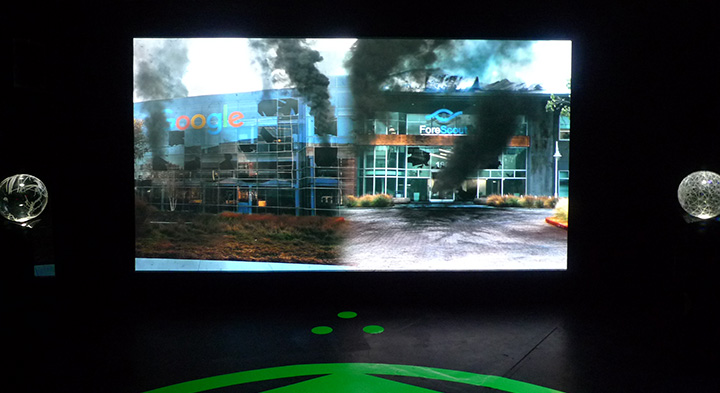
Along their travels, we encounter tech workers being taken hostage by “The Art Professor” wearing gray, paint-splattered coveralls and wielding a machine gun. Later in a classroom, the Art Professor introduces Nootropix (Cassils) who in their monologue states that they will perform the creation of gravity. The performance artist is powerful and their dance upon a purple matrix while dawning a large, erect, glowing CGI penis that is constantly spewing black liquid is awesome. The dance is mesmerizing and triumphant.
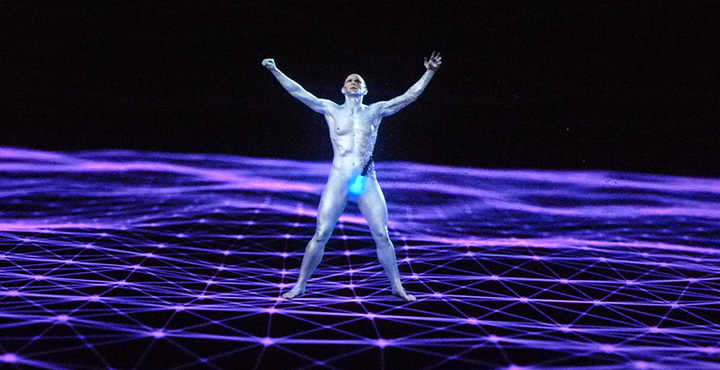
In Nootropix, Blas presents one of his contra-internet exotic creatures “to discover or create a world of network difference.” I could have entirely skipped the storyline, and merely be fantastically transported by Cassils’s character and performance as I think that it would have left me asking more questions and appreciating the mystery. We know that a network of difference is not plausible, so why not create the fantastic and shed the tedious philosophizing.
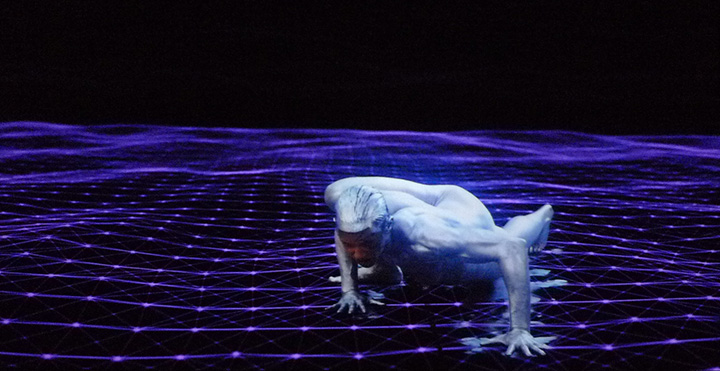
Chelsea Galleries September 2017
There are plenty of strong exhibitions in Chelsea this September into October. And the fancy blue chip galleries are presenting a racial and identity social consciousness as black artists receive recognition at at least a few major galleries. Here are a few that I enjoyed this past weekend.
Sanford Biggers: Selah, Sept 7th through October 21st at Marianne Boesky Gallery.
Kara Walker at Sikkema Jenkins & Co
Mark Thomas Gibson at Fredericks & Freiser through October 14, 2017